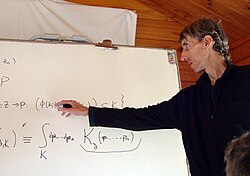Clifford Taubes | |
|---|---|
 Taubes in 2010. | |
| Born | February 21, 1954 New York City, New York |
| Alma mater | Harvard University |
| Known for | Taubes's Gromov invariant Bott–Taubes polytope |
| Relatives | Gary Taubes [1] |
| Awards | Shaw Prize (2009) Clay Research Award (2008) NAS Award in Mathematics (2008) Veblen Prize (1991) |
| Scientific career | |
| Fields | Mathematical physics |
| Institutions | Harvard University |
| Thesis | The Structure of Static Euclidean Gauge Fields (1980) |
| Doctoral advisor | Arthur Jaffe |
| Doctoral students | Michael Hutchings Tomasz Mrowka |
Clifford Henry Taubes (born February 21, 1954) [2] is the William Petschek Professor of Mathematics at Harvard University and works in gauge field theory, differential geometry, and low-dimensional topology. His brother is the journalist Gary Taubes.